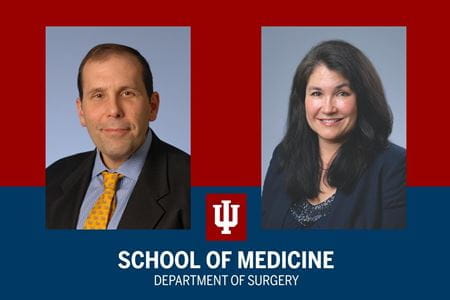Leonidas G. Koniaris, MD a professors of surgery and Teresa A. Zimmers PhD, the H.H. Gregg Professor of Cancer Research with the surgery department at Indiana University School of Medicine, were recently awarded a Research Project Grant or an R01 from the National Institute of Health. The research grant is conducting studies to understand how the body heals after surgery or trauma.
According to the NIH, the R01 grant is the highly competitive main grant mechanism used to support health research in the United States. The R01 provides support for health-related research and development based on the mission of the NIH. The grant is awarded to support a discrete, specified, circumscribed project performed by a named investigator or investigators in an area representing their specific interest and competencies.
"If you have a kidney injury or a liver injury, we don't know the mechanisms by which organs talk to other organs or tissues to heal," said Koniaris. "This process has been known for 80 years but to date the mechanisms that drive it are not understood. However, we believe we've identified some of the fundamental pathways for this process."
Koniaris explained that people don't eat their way to healing, but instead use preexisting stored nutrients within the body to supply the raw materials needed to recover. For example, extra stored proteins, fats, amino acids, and minerals are what the body uses to repair a damaged organ or tissue.
"What we've identified is, after major liver resection, major intestinal loss, or trauma the way you recover is: the damaged organ signals within the body, particularly impacting muscle and fat, and causes those tissues to provide the substrate and rebuild the damaged organ," said Koniaris. "Knowing this information can help us treat injuries that would be lethal and increase the survival of an otherwise unsurvivable injury."
The research will attempt to enhance the ability of different tissues to heal and learn how they support the repair of damaged organs. The study will also further explore these pathways on a molecular level to potentially stimulate and refine the repair process, improving outcomes for people with serious injuries or trauma. They will also attempt to understand if and how these same pathways may be detrimental.
An example Koniaris provides for the possibility of harm includes burn healing in children. After a child suffers a severe burn, they have found that some children are unable to gain weight, even after the burn has completely healed. They may even lose weight. Koniaris and Zimmers have identified that this same mechanism does not shut off, due to the body continuing to try to heal the burned skin.
"We think this research is important because recovery from surgery or trauma has the potential to greatly increase the safety margin for surgery and trauma patients as well as extend our ability to provide certain otherwise high-risk surgeries," said Koniaris. "That's always desirable, and we think it's fundamental since surgery is what we do."
In the next couple years, Koniaris and Zimmers plan to start developing the experiments that will become the base for his research.
"We have a lot of in-vivo and in-vitro experiments planned out," said Koniaris. "Such as experiments in different systems where we want to delineate the exact steps in these processes to understand how to manipulate, enhance, and turn on the pathways. We look forward to working hard."
